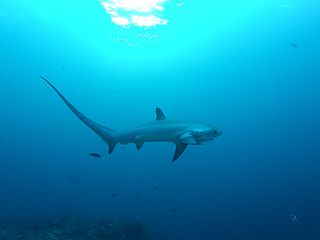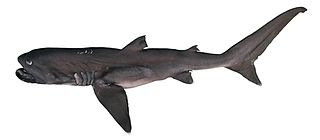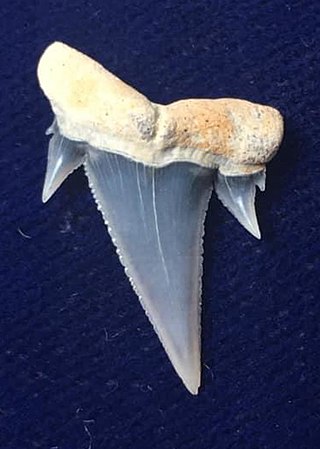
The megamouth shark is a species of deepwater shark. Rarely seen by humans, it measures around 5.2 m (17 ft) long and is the smallest of the three extant filter-feeding sharks alongside the relatively larger whale shark and basking shark. Since its discovery in 1976, fewer than 100 specimens have been observed or caught. Like the other two planktivorous sharks, it swims with its mouth wide open, filtering water for plankton and jellyfish. It is recognizable from its large head with rubbery lips. The megamouth is so unlike any other type of shark that it is usually considered to be the sole extant species in the family Megachasmidae, though some scientists have suggested it may belong in the family Cetorhinidae.

The Lamniformes are an order of sharks commonly known as mackerel sharks. It includes some of the most familiar species of sharks, such as the great white, as well as more unusual representatives, such as the goblin shark and megamouth shark.

Otodus megalodon, commonly known as megalodon, is an extinct species of giant mackerel shark that lived approximately 23 to 3.6 million years ago (Mya), from the Early Miocene to the Pliocene epochs. O. megalodon was formerly thought to be a member of the family Lamnidae and a close relative of the great white shark, but has been reclassified into the extinct family Otodontidae, which diverged from the great white shark during the Early Cretaceous.

Thresher sharks are large mackerel sharks of the family Alopiidae found in all temperate and tropical oceans of the world; the family contains three extant species, all within the genus Alopias.

The basking shark is the second-largest living shark and fish, after the whale shark. It is one of three plankton-eating shark species, along with the whale shark and megamouth shark. Typically, basking sharks reach 7.9 m (26 ft) in length. It is usually greyish-brown, with mottled skin, with the inside of the mouth being white in colour. The caudal fin has a strong lateral keel and a crescent shape. Other common names include bone shark, elephant shark, sailfish, and sunfish. In Orkney, it is called hoe-mother, meaning "the mother of the picked dogfish".

Cetorhinidae is a family of filter feeding mackerel sharks, whose members are commonly known as basking sharks. It includes the extant basking shark, Cetorhinus, as well as two extinct genera, Caucasochasma and Keasius.

Megachasma is a genus of mackerel sharks. It is usually considered to be the sole genus in the distinct family Megachasmidae, though suggestion has been made that it may belong in the family Cetorhinidae, of which the basking shark is currently the sole extant member. Megachasma is known from a single living species, Megachasma pelagios.

Otodus is an extinct, cosmopolitan genus of mackerel shark which lived from the Paleocene to the Pliocene epoch. The name Otodus comes from Ancient Greek ὠτ- and ὀδούς – thus, "ear-shaped tooth".

Sometimes called the bearded toadheads but better known by their scientific name of Phrynops this genus of turtles has often been a bit of a dumping ground for the short-necked South American turtles of the family Chelidae.
Nanocetorhinus is an extinct genus of sharks in the subclass Neoselachii. The type and only described species is N. tuberculatus, which existed in what is now Slovakia during the Miocene epoch, and was described by Charlie J. Underwood and Jan Schlogl in 2011. It was described from 28 fossilized teeth.

Cretalamna is a genus of extinct otodontid shark that lived from the latest Early Cretaceous to Eocene epoch. It is considered by many to be the ancestor of the largest sharks to have ever lived, such as Otodus angustidens, Otodus chubutensis, and Otodus megalodon.

Galeomorphii is a superorder of sharks. They are sometimes called galea or galean sharks. There are about 300 living species in 23 families. Galean sharks are divided into four orders: the Heterodontiformes, Orectolobiformes, Lamniformes, and Carcharhiniformes. The extinct, enigmatic Synechodontiformes are presently placed by some authors in the galeomorphs, but their taxonomic position still remains uncertain.
The Astoria Formation is a geologic formation in Washington state & Oregon. It preserves fossils dating back to the early to middle Miocene.

The Keasey Formation is a geologic formation in northwestern Oregon. It preserves fossils dating back to the Paleogene period.
This list of fossil fishes described in 2015 is a list of new taxa of jawless vertebrates, placoderms, acanthodians, fossil cartilaginous fishes, bony fishes and other fishes of every kind that have been described during the year 2015, as well as other significant discoveries and events related to paleontology of fishes that occurred in the year 2015. The list only includes taxa at the level of genus or species.

Pseudocorax is an extinct genus of mackerel sharks that lived during the Late Cretaceous. It contains six valid species that have been found in Europe, the Middle East, North Africa, and North America. It was formerly assigned to the family Anacoracidae, but is now placed in its own family Pseudocoracidae along with Galeocorax. The former species "P." australis and "P." primulus have been reidentified as species of Echinorhinus and Squalicorax, respectively.

Paraisurus is an extinct genus of mackerel sharks that lived during the Cretaceous. It contains four valid species, which have been found in Europe, Asia, North America, and Australia. A fifth species, P. amudarjensis, is now considered a synonym of P. compressus. While this genus is mostly known from isolated teeth, an associated dentition of P. compressus was found in the Weno Formation of Texas. It went extinct around the Albian-Cenomanian boundary, as a supposed Coniacian occurrence of "P. sp." is likely a misidentified pseudoscapanorhynchid.

Carcharoides is an extinct genus of mackerel shark which lived during the Oligocene and Miocene epochs. It is a widespread genus, known from specimens in North and South America, Europe, Africa, and Australia. It is most common in the European portion of its range, being comparatively uncommon in other places. It is only known from isolated teeth, which are relatively delicate.

Pseudoscapanorhynchidae is a family of extinct mackerel sharks that lived during the Cretaceous and potentially the Paleogene. It currently includes Cretodus, Eoptolamna, Leptostyrax, Protolamna, Pseudoscapanorhynchus, and possibly Lilamna.
Caucasochasma is an extinct genus of basking sharks that lived during the Oligocene. It contains one valid species, C. zherikhini. It is known from a mostly-complete skeleton from the Pshekha Formation of Russia. It has a body plan more similar to sand sharks than to extant basking sharks, which indicates that it was a benthic filter feeder.














